When I was a kid, I remember watching my parents switch between different credit cards to get the best rewards for a particular purchase. They almost always pulled out the American Express first because (as they explained to me) the base reward rate was higher than even the sector-specific perks offered by other cards. Twenty years later, when I decided to get a high-end credit card, Amex was the first one that came to mind.
Customer journey mapping is the process of planning out people’s awareness of and relationship to your brand, starting with their very first impression—even if, as in my case, that impression is made a full decade before they can actually use your product.
Table of contents:
What is a customer journey map?
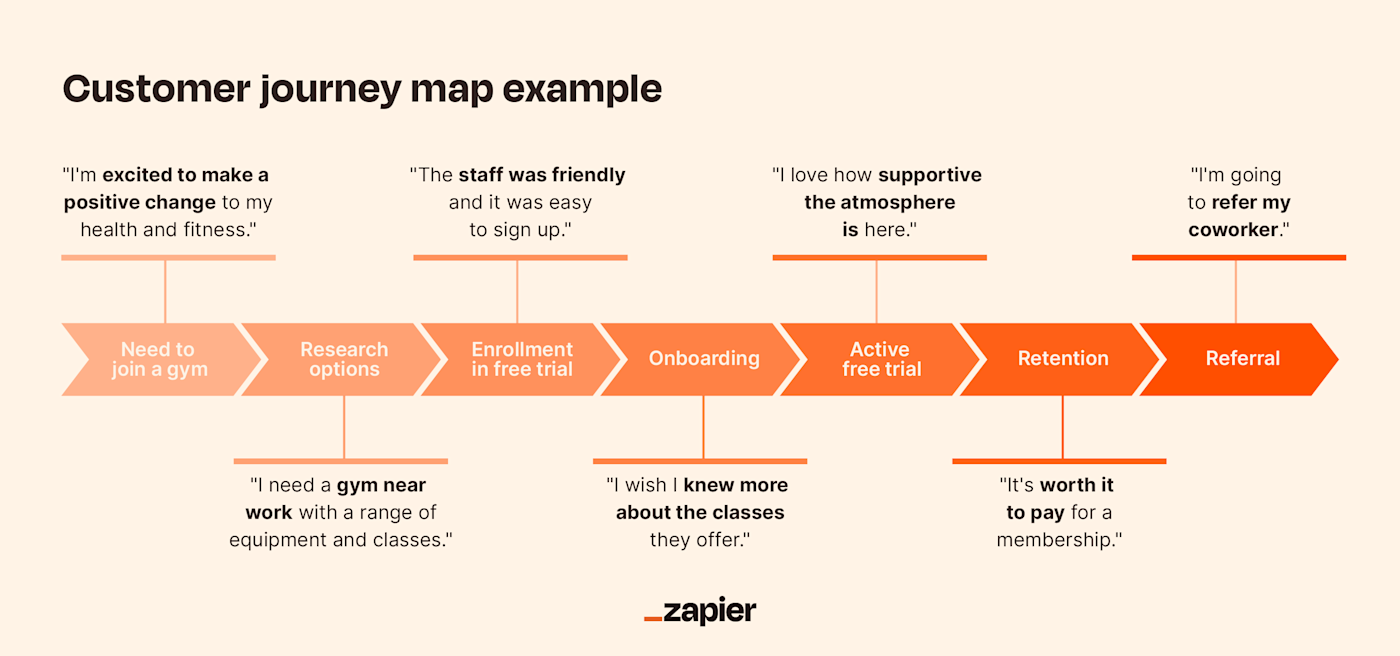
A customer journey map is a visual representation of the grand journey your customer takes from awareness to prospective buyer to loyal and devoted customer. This journey may take many twists and turns, through the hedges of social media to the fires of Mount Sales—but with a customer journey map, you’ll never have to wonder where you (or your customer) will end up.
The customer journey is split into two parts: the buyer journey and the user journey. The buyer journey covers everything up to the point of purchase. After that point, the customer becomes a user, and all of their experiences are part of the user journey.
Think back to any recent purchase of your own, and try to trace your own customer journey:
-
When and where was your first contact with the product or service?
-
How many channels of communication with the company did you have available?
-
How was the contact you had, if any? Was it personal or formulaic?
-
Were your problems, if any, solved? If so, were they solved in a timely manner?
-
What do you now know about the brand besides the product or service itself?
Of course, every customer is different. But you can’t create a customer journey map for every individual—and you don’t need to. Instead, you can segment your audience into customer personas and create a map for each.
Stages of the customer journey
The customer journey map can be split into five phases: awareness, consideration, conversion, retention, and brand loyalty.
Awareness
Customers can’t decide whether or not they want your product if they don’t know that it exists. In the earliest phase of the customer journey, a business’s goal is to reach the individual and, ultimately, attract them to the brand.
For a small- to medium-sized business, the work of this stage involves reaching out directly to consumers via channels like advertising, SEO, and social media. For a household name like American Express, this stage is dedicated to ensuring the impression their brand makes is a positive one.
Consideration
Once potential customers are aware of your brand, the next phase they enter is called “consideration” or “research.” This is when the customer’s perspective shifts from simple awareness of your brand’s existence to an understanding of the value that you have to offer them.
During this phase, the brand’s goal is to design touchpoints that demonstrate to the user why their product can solve a problem or improve an experience that’s specific to that person. This can be done using guides and how-tos, partnerships with other brands, and ads that portray a customer problem being solved.
Some businesses also include a mini-stage called “Intent” or “Onboarding,” when the customer has decided they’re interested in the product and is testing it out. The company’s goal in this stage is simply to provide an exceptional user experience—they want to make sure the product works as intended and the customer’s questions and requests are handled well.
Conversion
A business can identify customers that are primed for conversion based on behavior in the consideration stage. Someone who signs up for a newsletter isn’t a hot sales prospect quite yet, but when they start opening more emails and spending more time on the site, that’s when brands know they’re ready for a conversion push.
Types of conversions vary depending on the type of business and industry. Examples of conversion pushes include:
-
An abandoned cart email pushing a browsing shopper to complete a purchase
-
A physical mail offer pushing a potential customer to open an account
-
A seasonal campaign highlighting why a product is perfect for a particular holiday, celebration, or event
Retention
When a conversion is successful, a potential buyer becomes an actual customer. The goal in the retention stage is to demonstrate to the customer why they were right to make their purchase, and set them up to make more purchases or renew services in the future.
The retention stage is also where the user experience or user journey begins. The company’s job in this phase, then, is to provide the best possible user experience. Easy installation, frictionless customer service, and—this part should be obvious—a product or service that works well and provides the user what they need are all key components to improved customer retention.
Brand loyalty
In the final customer journey phase, users go from run-of-the-mill satisfied customers to active advocates for your business.
You can encourage brand loyalty by offering exceptional customer service, referral programs, and loyalty discounts and exclusives.
Keep in mind: a customer doesn’t need to be a zealot for your company to be an unintentional brand advocate. One of the biggest reasons I made the decision to apply for Amex’s high-end card is because my best friend has it. She didn’t specifically recommend it to me, but I became interested after experiencing a lot of the card benefits vicariously through her.
Parts of a customer journey map
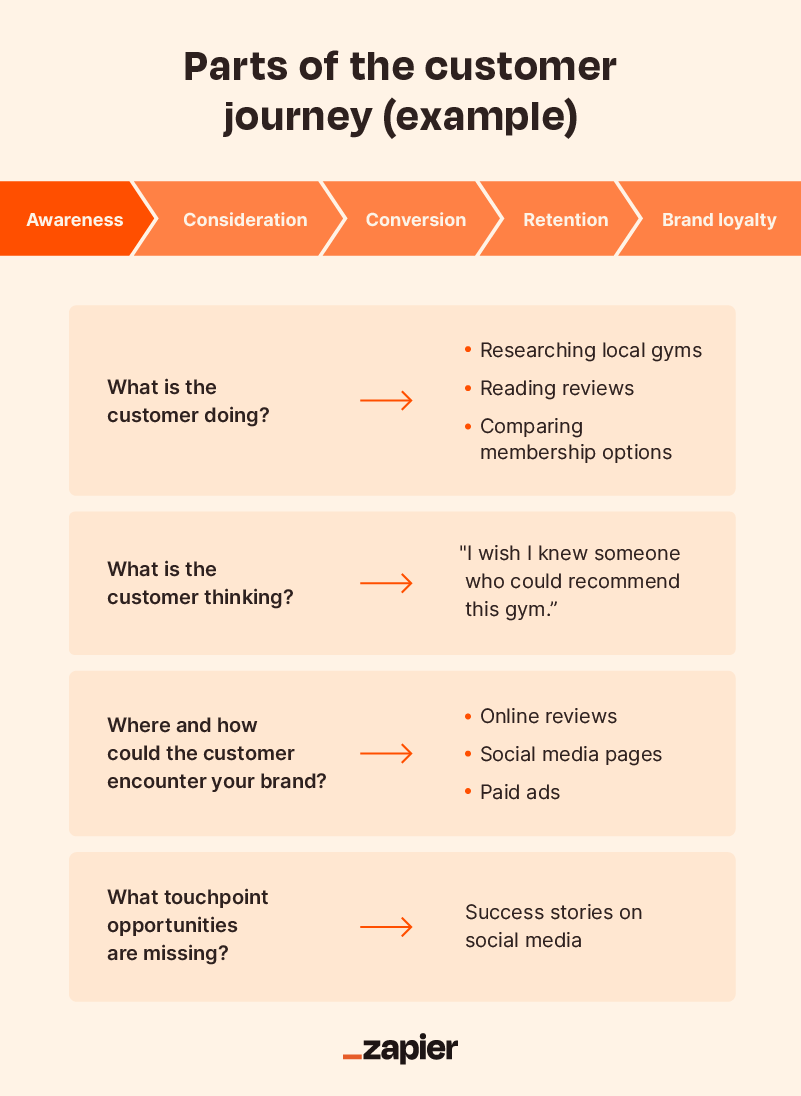
If you’re already familiar with journey mapping, you can skip the formalities and jump to our templates and start filling one in. If you’re not so familiar, you’ll probably want to acquaint yourself with this quick overview of customer journey map components first. These aren’t specific to our templates, but they’re pretty core to any journey mapping process.
-
What is the customer doing? In this section, you’ll jot down the main things the prospect, lead, or customer does during this stage. For example, if you’re a personal trainer, an awareness stage key step might include something like “Prospect wants to get in shape.”
-
What is the customer thinking? Put yourself in the customer’s shoes and think about what questions they might have at each stage. In the consideration phase, questions like “Is this worth my time/money?” or “Will this help me solve my problem?” will come to the forefront.
-
Where and how could the customer encounter our brand? After you’ve outlined what your customer is thinking at each stage, align each question with the relevant touchpoint that could address it. Each question must have at least one touchpoint that directly and specifically addresses the customer’s needs and questions at that point.
-
What touchpoint opportunities are missing? When you have a question or milestone that doesn’t have a corresponding touchpoint, you’ve found a gap in your customer journey. That means customers at this stage are going to be left with unmet needs and unanswered questions and may look more seriously at competitor products as a result. You’ll need to develop touchpoints to fill this gap.
How to create a customer journey map
Now, let’s get down to creating a customer journey map for your business. You know what you’re doing and why, but the how remains unexplored territory. If you already have a template or structure you like to use, awesome. If not, pick one of our templates below—then you can dive in.
Step 1. Define objectives
The first step is to identify the goals of the journey map. Start by asking yourself these questions (or similar ones):
-
Do you want to sell more products to a specific customer base?
-
Do you want to close more of your existing deals?
-
Do you want to find out why no one is adopting the latest addition to your product or service?
Understanding your goals is crucial to making the most of this mapping exercise because they help establish trajectories, timelines, and KPIs. You need to know what wins will have the sales team at your desk with confetti, and which ones won’t move the needle quite as much.
Step 2. Create personas
If you don’t already have customer personas created, now is the time to do it. Develop two to three detailed customer or user personas representing your target audience, and use these personas in your customer journey mapping exercise.
Some good questions for this stage in the process include:
-
Why are people using your system, product, or service?
-
What problems do people use your product to solve?
-
How, when, and where do they use your product or service?
These hypothetical users should help you visualize how individuals discover and interact with your brand and why they might look to your products over competitors’ or to solve specific pains with no current solutions.
Step 3. Collect data
Next, grab your metaphorical shovel and dig into the data. Reach out to sales, marketing, or customer experience teams to find out more about the journey itself. You can gather qualitative and quantitative data from customer feedback, past marketing campaigns and sales figures, and third- or first-party market research that will make your customer map more accurate.
Here are some examples of data you’ll want to collect:
-
Stages of the sales process
-
Common sales pain points
-
Market segmentation criteria
-
Customer feedback on the sales and support processes
-
Any other information your teams suggest including in your map
Step 4. Map stages
Once you know your objectives and the hypothetical customers you want to achieve them with, you’ll get out your customer map (and all that delicious data you just collected) and list all touchpoints where customers interact with your brand. These should fit, at least loosely, into the stages of the customer journey listed above:
-
Awareness
-
Consideration
-
Conversion
-
Retention
-
Brand loyalty
Depending on the complexity of your sales tactics, your brand may have additional stages to include in that list or may have substitutions, but for most products or services, these five are pretty fundamental to successful, repeatable sales processes.
Step 5. Visualize and analyze
Using your customer journey data and newfound insight into the stages of your brand’s sales process, you can now build out a visual map of the customer journey. Do this using one of our templates or by using your own research as inspiration to plot a map tailored to your products or services.
Bonus: Share
Once you’ve filled out your map, it’s a good idea to share it with relevant team members to get feedback on touchpoints from their perspectives. Your marketing team, for example, might notice that some personas are more likely to interact with your brand via social media than PPC ads, or your UX team might notice that some target personas are actually likely to be more interested in a product feature you hadn’t thought to connect them to.
Customer journey map templates
We have you covered with some map templates for common customer journeys. You can customize each of these to fit the individual needs of your personas. Singing “The Road Goes Ever On” as you set out is optional but encouraged.
General customer journey map template
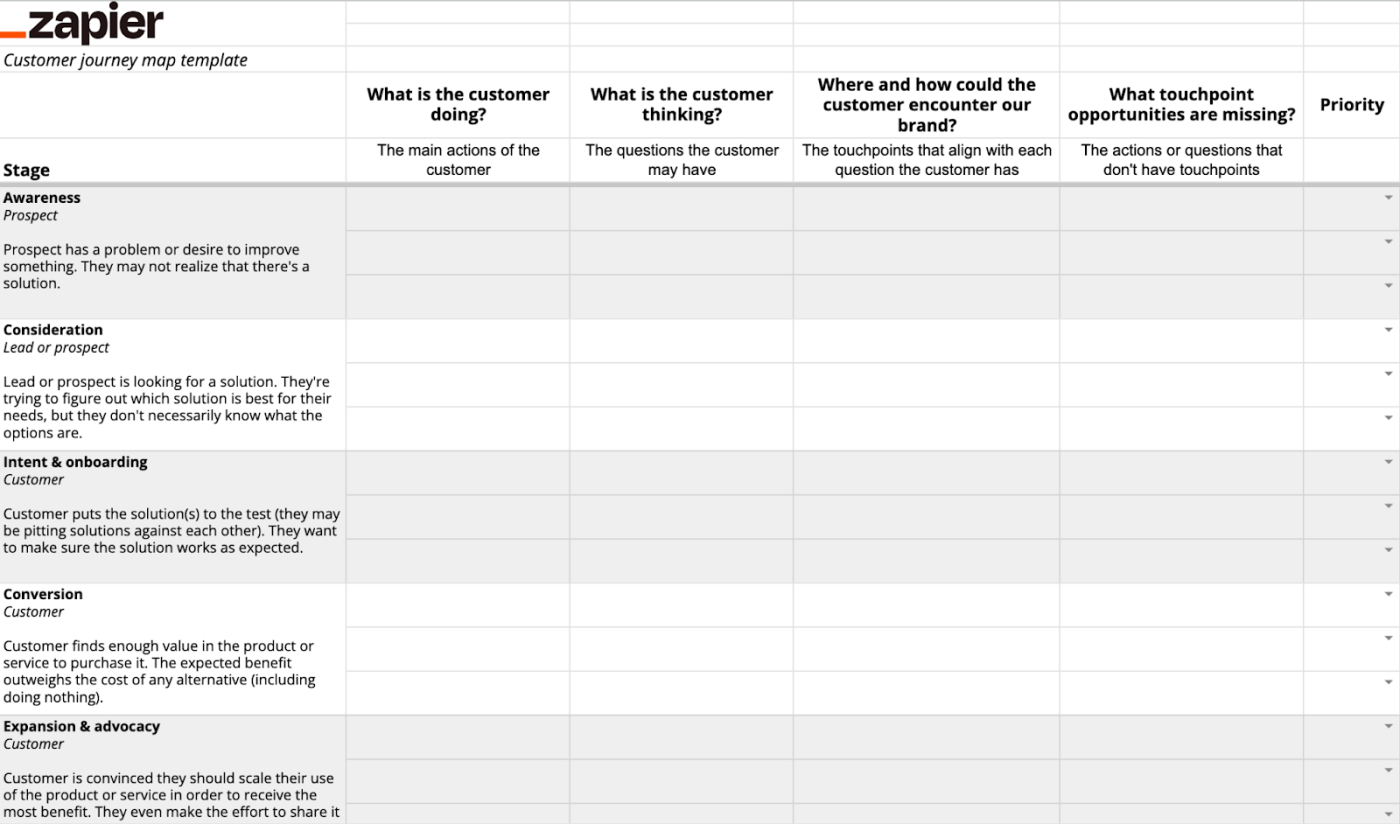
This customer journey map template is separated into five stages along the leftmost column, with guiding questions to help plan the customer’s experience in each stage. Make a copy of the Google Sheets file, and then you can easily tweak it to match your preferred stage names and questions.
Day in the life map template
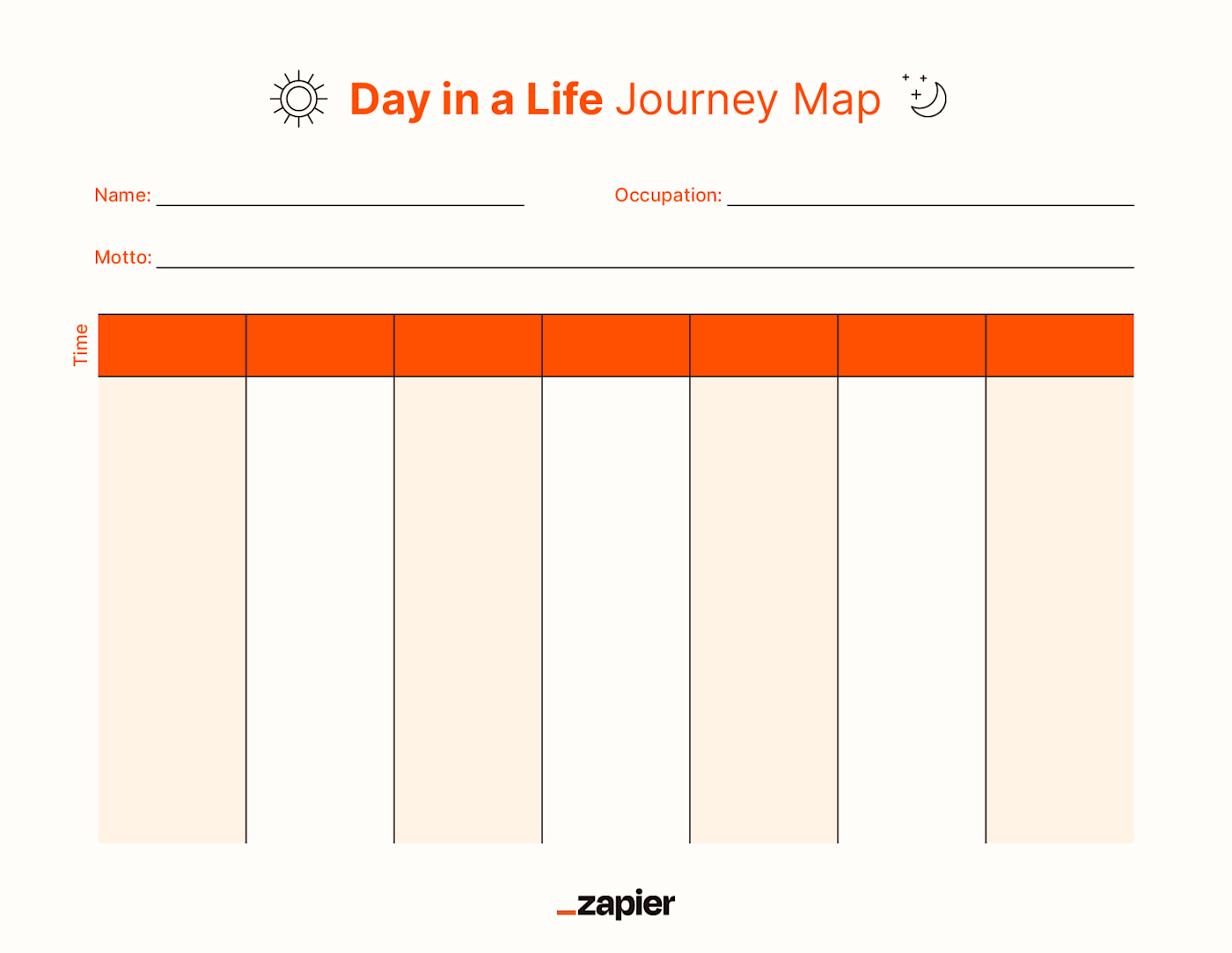
A great way to map mini-journeys within the larger customer experience lifecycle is with a “day in a life” journey map. This map plots the same things as the general customer journey map—key milestones, questions, touchpoints, and gaps—but over a particular period of time instead of over the course of the entire relationship.
Customer support journey map template
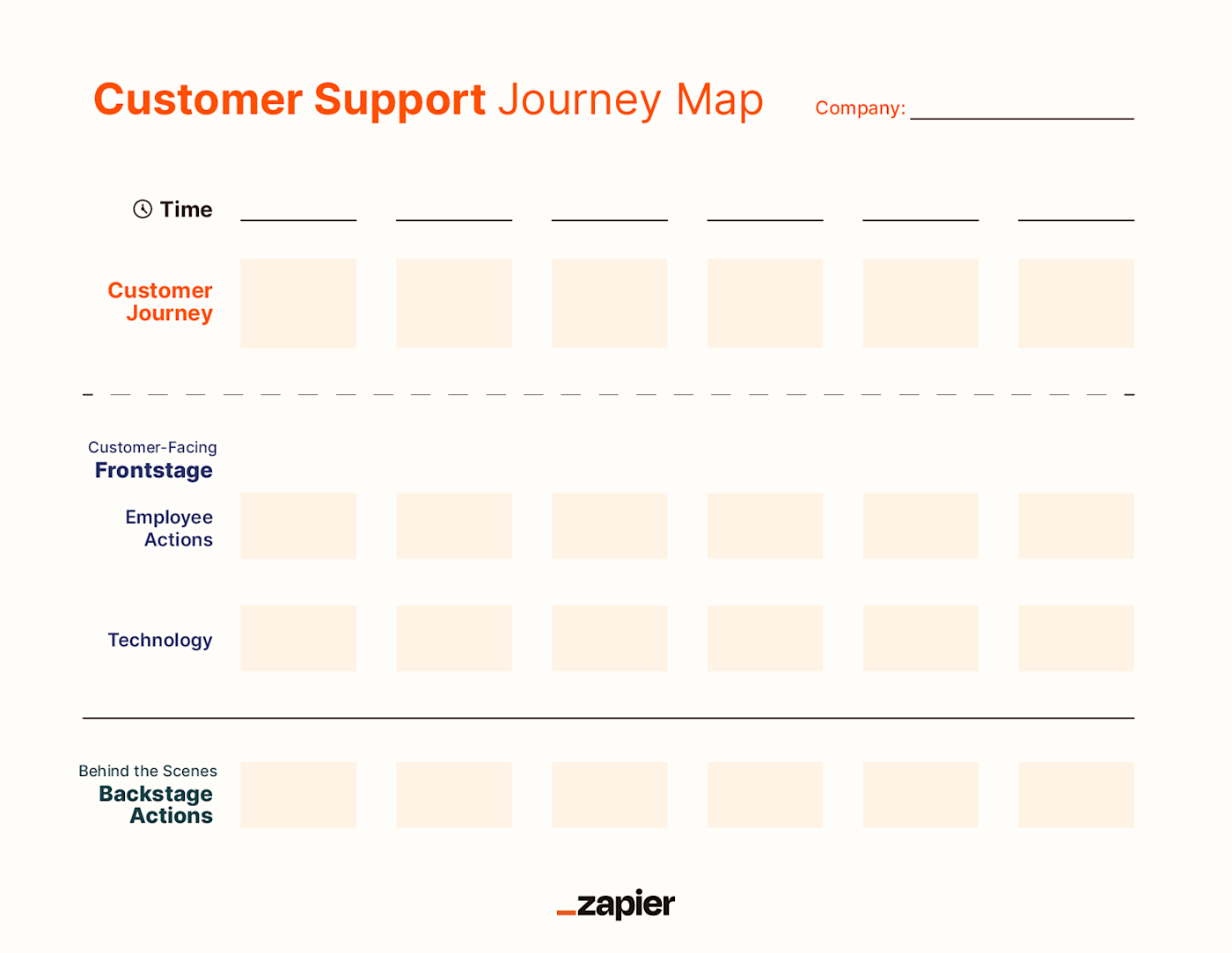
Another side of the customer journey coin is the support journey. This journey map is a bit different in that it doesn’t just map touchpoints; it maps functional interactions between the customer and customer service representatives as well as the behind-the-scenes activities necessary to support the customer-facing team. It also gives you space for summary notes to help you focus on high-level staging structure.
Benefits of customer journey mapping
In a world where there are multiple high-quality options for just about every product on the market, brands need to foster long-term relationships with their customers to prevent them from being poached by competitors who offer a better customer experience.
Here are the main benefits of the customer journey mapping process:
-
Touchpoint optimization: With a clear understanding of what your touchpoints are and where they occur, you can track and adjust them based on how they perform.
-
Enhanced customer experience insights: Through customer profiling and a better overview of all the touchpoints that make a journey, you can acquire more precise and actionable customer experience insights.
-
Improved product development: Thoughtful and intentional journey planning creates more opportunities for meaningful customer feedback, which gives businesses better information to improve their product.
Examples of customer journey maps
A blank page is inspiring (said no one ever), but to help you get a better sense of what the end result might look like, here are some examples of completed customer journey maps.
General customer journey mapping example
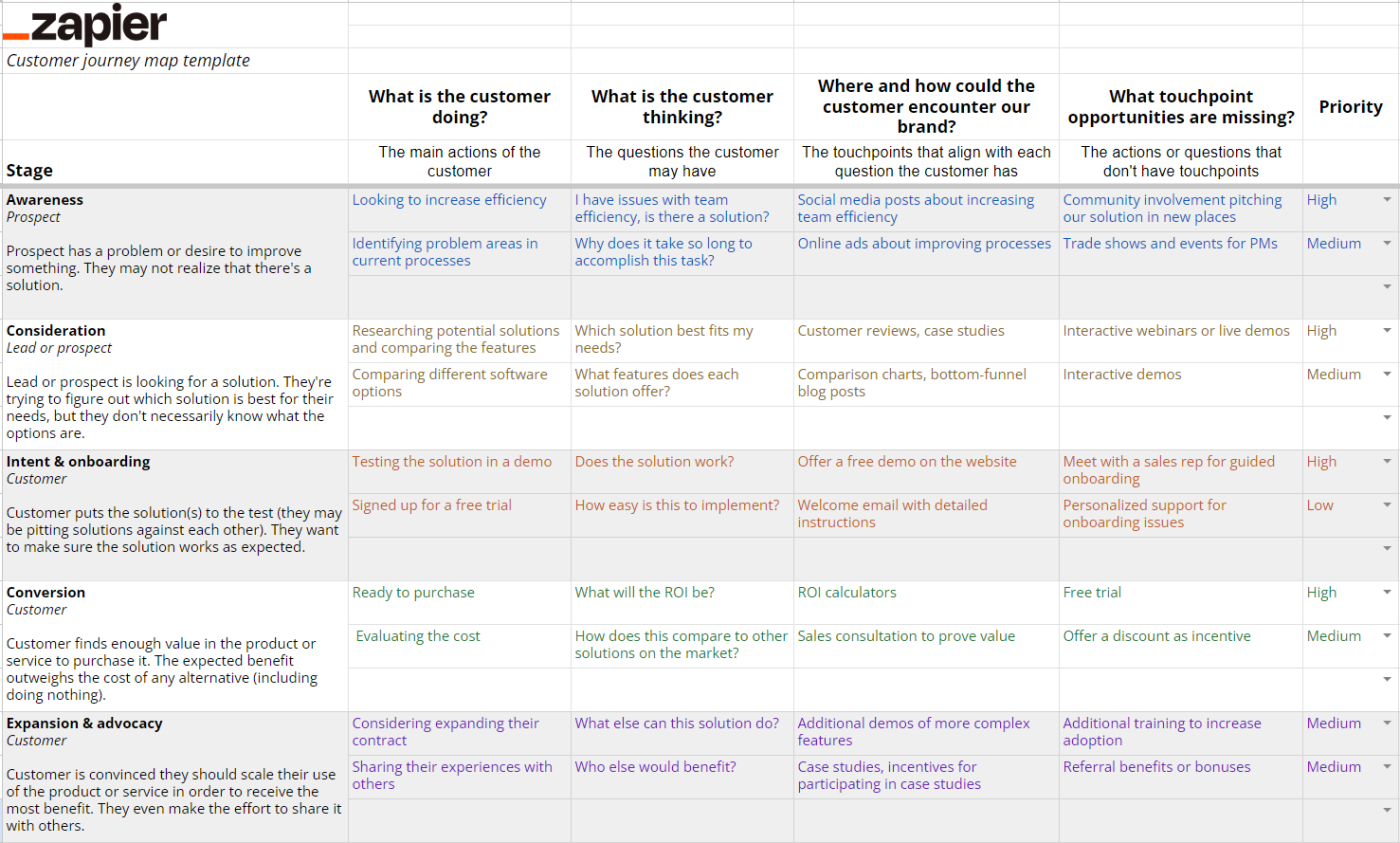
In this example, a SaaS company similar to Zapier has filled out this general customer journey map and documented the customer’s journey step by step.
-
Awareness: The customer has identified the problem as efficiency in their processes. They’re asking questions about potential solutions—and as a result, may see targeted ads or social posts based on their searches offering a solution.
-
Consideration: The customer is doing their research and comparing options. They’re comparing features between similar products and reading case studies.
-
Intent and onboarding: Here’s where the rubber meets the road. The customer is taking the solution for a test drive and may even have a free full-access trial.
-
Conversion: The customer is now ready to purchase. They may have a few final questions about ROI and price, but value has been established.
-
Expansion and advocacy: Finally, the customer has developed such an appreciation that they’re ready to advocate—or even increase the number of services they purchase from you.
While your stages may look a little different, the key here is to understand what questions your customers ask at each stage—and how to answer them.
Day in the life mapping example
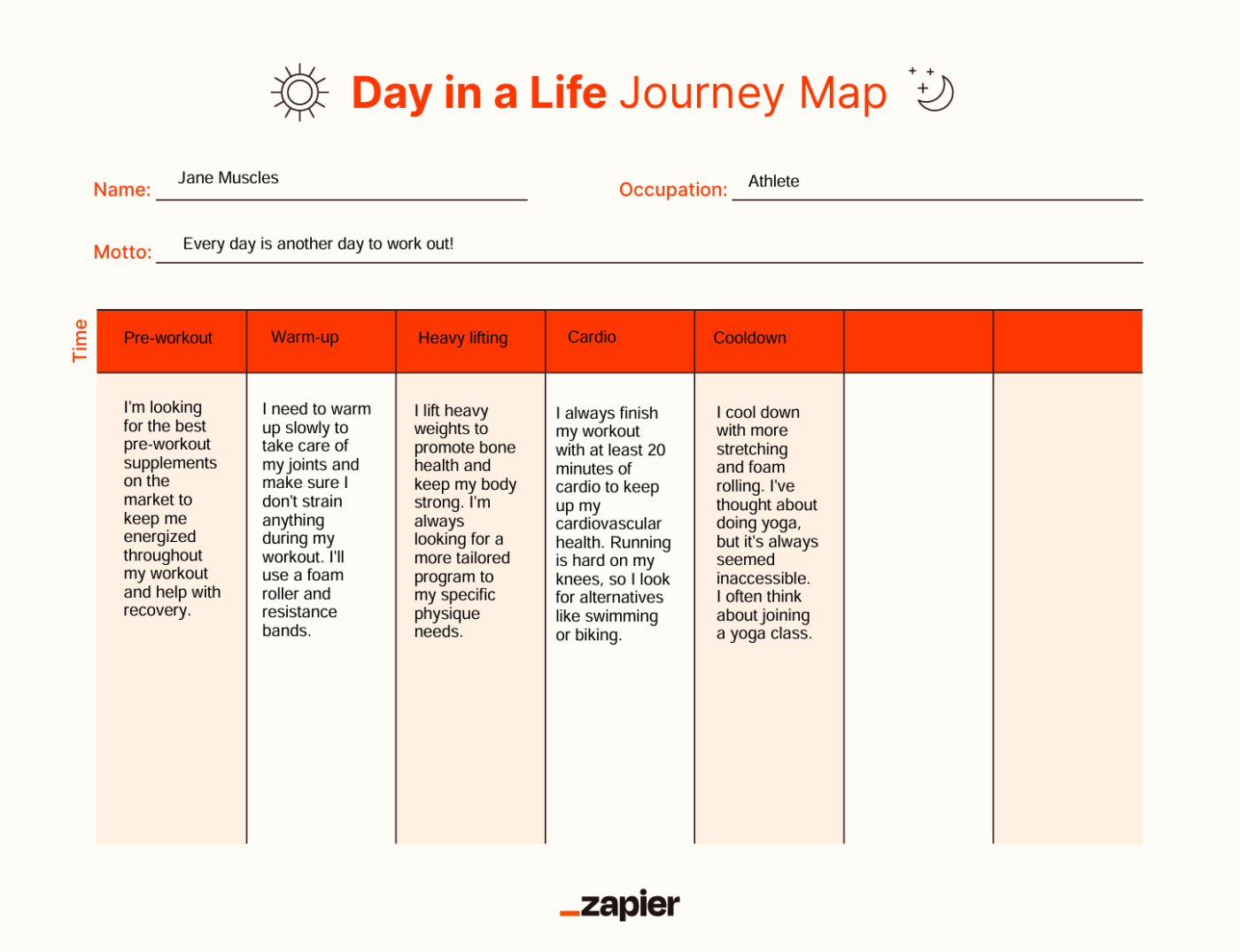
In this example, a company that sells workout equipment has filled out a day-in-the-life customer journey map for one of their personas. This persona is dedicated to her training and always looking for a new tool, gadget, program, or supplement to increase her performance.
This journey is broken down into stages of the workout:
-
Pre-workout: The customer, Jane, takes her supplements and evaluates her stack. She might purchase additional supplements.
-
Warm-up: Jane uses tools to help her warm up, including resistance bands. She would likely purchase additional tools to assist with this stage.
-
Heavy lifting: Jane goes from her warm-up to the weight rack. We can infer that she probably has a gym membership.
-
Cardio: Jane is likely to explore other cardio options and might buy more equipment to support these endeavors. This could include a heart rate monitor, a jumping rope, or a new bike.
-
Cooldown: This is similar to the first stage but could include additional purchases like a sweat towel or a moisture-wicking top.
Each of these stages in the day-in-the-life journey offers a new opportunity to identify and meet a customer need.
Customer support journey mapping example
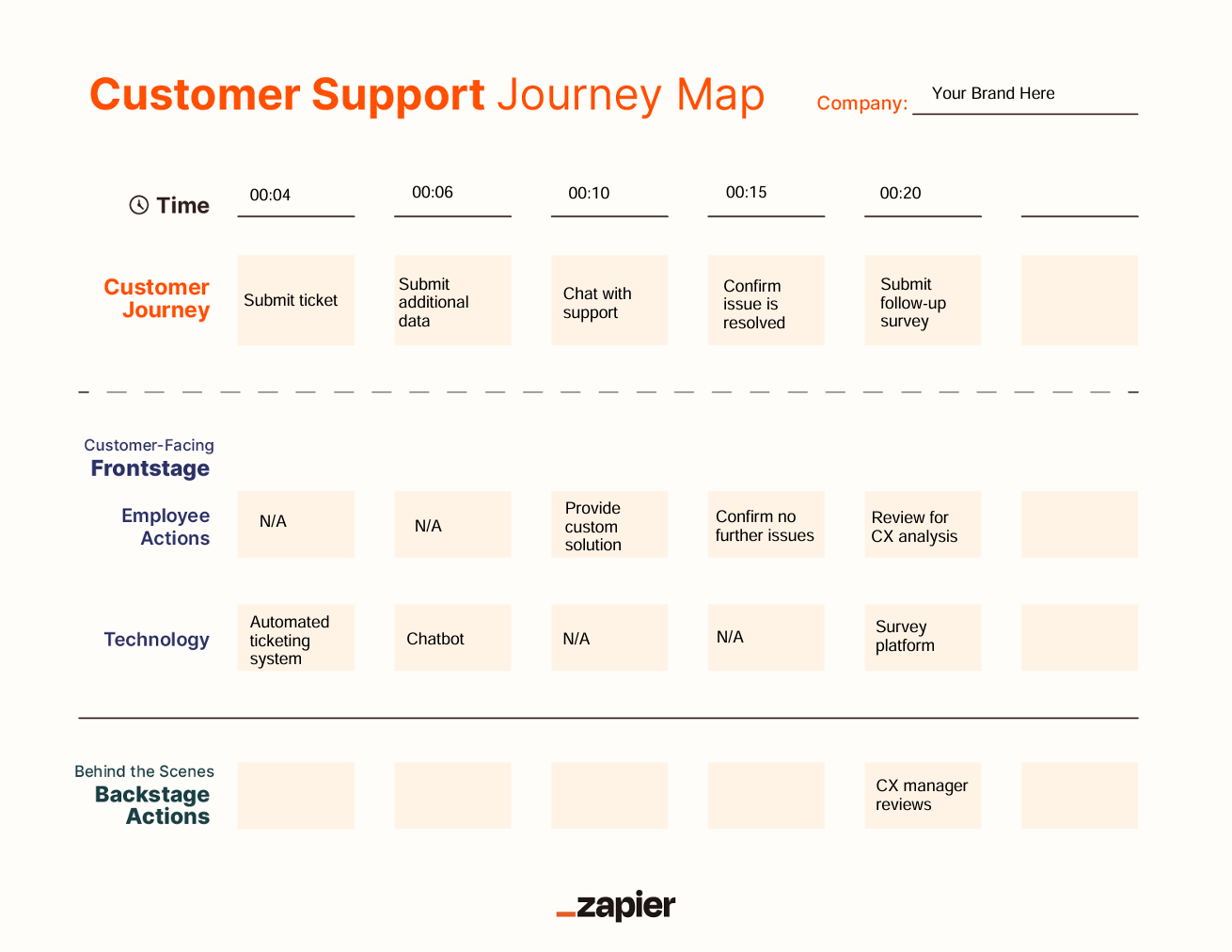
In this example, a customer goes through the support system process, interacting with both human support representatives and the automated systems that assist them. The whole process takes less than 20 minutes—but analyzing it can offer significant insights into how to better help and retain customers.
-
Submit ticket: The first stage begins when the customer experiences an issue and submits a ticket. This occurs automatically using a chat or form submission system—so it’s important to make sure those systems are working correctly.
-
Submit additional data: An automated system typically follows up by asking some additional questions about the issue before transferring the customer to a support representative.
-
Chat with support: This is when a human steps in to resolve any remaining issues that the automated system can’t solve. This transition should be as seamless as possible for the best CX.
-
Confirm issue is resolved: Did you resolve the issue for which the customer submitted the ticket? Failing to confirm this can be the difference between keeping or losing a customer.
-
Submit follow-up survey: Finally, the last stage is for the customer to submit their feedback on the support process so that your CX team can learn more about how to better help future customers.
Obviously, this process looks much different than the first two since it focuses on internal responses to existing users or buyers, but optimizing your support processes for current customers is just as crucial as supporting future customers.
Customer journey mapping best practices
Everything we’ve covered up to this point will only get you as far as a basic customer journey map. That doesn’t mean, however, that your customer journey map will be good. Once you have the basic journey mapping structure down, you’ll want to take steps to continually improve your map’s effectiveness.
Survey your customers and customer teams
When designing touchpoints and determining where and how customers interact with your business, don’t guess—your existing customer base is a valuable resource you can tap for a firsthand customer perspective. You can incentivize customers to participate in surveys and fill out feedback forms by offering discounts and perks in exchange.
Talk to your customer-facing employees, too. The people who work directly with customers day-to-day will have more accurate information about how to interact with them.
Automate customer data collection
High-quality, premium experiences are defined by their high level of personalization, and that personalization is only possible if you have information about your customer. It’s not possible to sit there and take notes on every person who interacts with your brand, but it is possible to automatically collect lead data from customer interactions and have them collated in your CRM tool.
Set up your contact management platform to automatically tag contacts with information like gender, age, products they’ve bought, events they’ve attended, what types of emails they open consistently and what emails they regularly ignore, whether their purchases indicate that they have pets or children, and so on. The more information you have, the better your customer experiences will be.
Tweak for B2B, B2C, and SaaS industries
The nature of the customer journey is different for SaaS, B2B, and B2C companies. A B2B company’s interactions with prospects might include in-person conferences, while a SaaS company’s touchpoints will be mostly digital. Companies that sell to consumers will need to think through individual people’s daily experiences. A company whose products are designed for emergencies will need to think through crisis scenarios instead of day-to-day customer experiences.
Tweak your customer journey categories to fit your company, product, and industry. Using a generalized or poorly fitting customer journey map will result in vague and unhelpful interactions with your brand.
Create multiple maps for different journeys
When people refer to the customer journey, they’re typically talking about the overarching journey from awareness to brand loyalty that we outlined above. But you can map any part of the customer journey and experience.
-
Do you target college students? Replace the five stages with four academic quarters and map their experience over the course of a year.
-
Is your product designed to be used in the car? Map the customer journey through each hour of a long road trip.
Zooming in to create detailed maps of different aspects of the customer journey will help you create even more specifically tailored customer experiences.
Automate your customer journey mapping with Zapier
Your customers’ spending habits, interests, challenges, and problems are always changing, and your customer journey maps should adapt along with them. But with so much data to track, you need to connect your insights to your CRM software. Then you can automate your CRM to create specific, valuable experiences for your customers without breaking a sweat.
Across thousands of apps, Zapier can automate tedious (but necessary) lead capture and nurturing tasks like creating new contacts from leads acquired through ads and adding new contacts to subscription lists. Here are some examples to get you started.
Zapier is the leader in workflow automation—integrating with 6,000+ apps from partners like Google, Salesforce, and Microsoft. Use interfaces, data tables, and logic to build secure, automated systems for your business-critical workflows across your organization’s technology stack. Learn more.
Related reading:
This article was originally published in May 2021 by Nick Djurovic. The most recent update was in August 2024 with contributions from Abigail Sims.